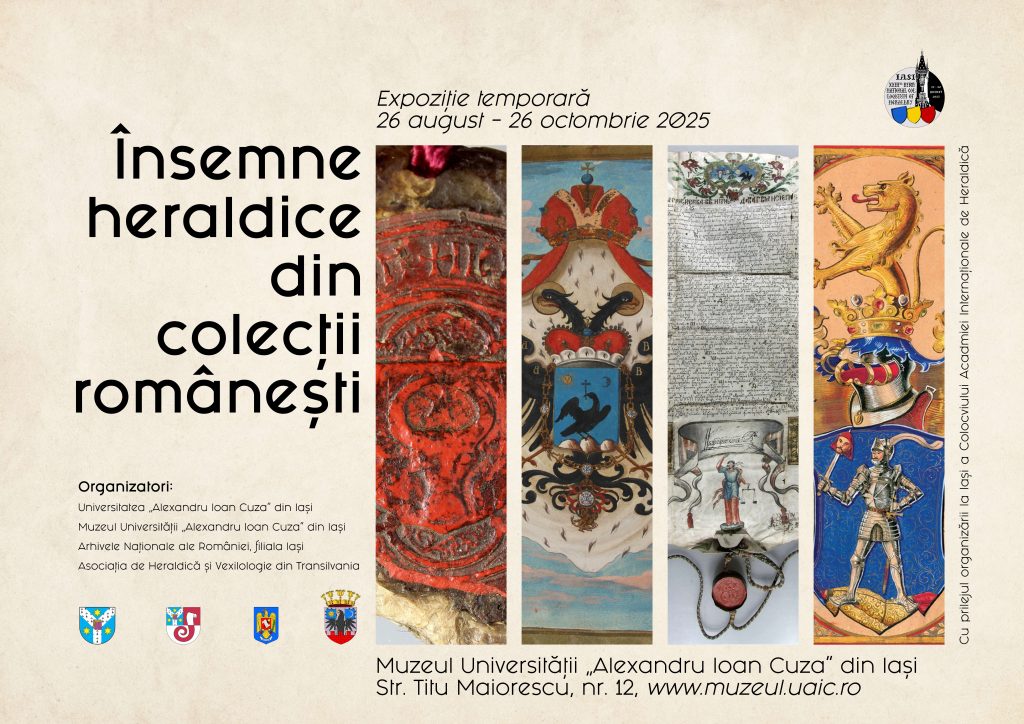Expoziția temporară „Însemne heraldice din colecții românești”
În perioada 26 august – 26 octombrie 2025, la sediul Muzeului Universității „Alexandru Ioan Cuza” din Iași (Strada Titu Maiorescu 12), se va putea vizita o expoziţia „Însemne heraldice din colecții românești”, organizată în colaborare cu Filiala Iaşi a Arhivelor Naţionale ale României, precum și cu Asociaţia de Heraldică şi Vexilologie din Transilvania.
Pornind de la specificul colecțiilor deținute de fiecare entitate parteneră, expoziția are o dublă dimensiune: pe de o parte, manuscrisele și impresiunile sigilare provenite din bogatele fonduri arhivistice ale Iașului pun în lumină uzanțele heraldice ale spațiului extra-carpatic (îndeosebi din Principatul Moldovei), un spațiu de cultură ortodoxă, deschis către influențele răsăritene, dar totuși deschis către fenomenul heraldic central-european; pe de altă parte, reproducerile după opera heraldică a lui József Sebestyén de Keöpeczi (1878-1964) constituie un excelent instrument de înțelegere a specificului armorial din Transilvania – parte integrantă a fenomenului heraldic central-european.
Tot astfel, în vreme ce materialul arhivistic ieșean pune în evidență o viziune mereu capricioasă asupra heraldicii, dar și o artă care are farmecul ei incontestabil (îndeosebi pentru perioada dinaintea secolului 19), desenele lui József Sebestyén de Keöpeczi aduc o certă rigoare artistică, precum și un stil care ar fi meritat să fie promovat mai mult în Occident. Pe de altă parte, compozițiile celui din urmă sunt interesante și pentru că ilustrează steme mai vechi, de regulă acordate în secolul 17, aceste compoziții arătând privitorului un specific intra-carpatic.
Această dublă dimensiune expozițională prezintă avantajul acoperirii întregii cronologii a heraldicii – în spațiul României de astăzi: din Evul Mediu până în Perioada Contemporană. Pentru că tot József Sebestyén de Keöpeczi a fost cel care, în 1921, a desenat, la invitația Regelui Ferdinand I și a Reginei Maria, stema de stat a Regatului României de după Primul Război Mondial. Cu stema desenată de el se încheie o evoluție care a început în pecețile și hrisoavele voievozilor Moldovei și ai Valahiei, iar stema desenată de el a fost preluată, cu unele modificări, de către România actuală.
***
TEMPORARY EXHIBITION “HERALDIC SYMBOLS FROM ROMANIAN COLLECTIONS”
From 26 August to 26 October 2025, at the headquarters of the “Alexandru Ioan Cuza” University Museum in Iași (Strada Titu Maiorescu nr. 12), visitors will be able to view an exhibition entitled “Heraldic symbols from Romanian collections”, organized in collaboration with the Iași Branch of the National Archives of Romania and the Association of Heraldry and Vexillology of Transylvania.
Based on the specific collections held by each partner entity, the exhibition has a dual dimension: on the one hand, the manuscripts and seal impressions from the rich archival funds of Iași highlight the heraldic customs of the extra-Carpathian space (especially from the Principality of Moldavia), an area of Orthodox culture, open to Eastern influences, but also open to the Central European heraldic phenomenon; on the other hand, the reproductions of the heraldic work of József Sebestyén de Keöpeczi (1878-1964) are an excellent tool for understanding the specific nature of the armorial of Transylvania – an integral part of the Central European heraldic phenomenon.
Similarly, while the archival material from Iași highlights an ever-capricious view of heraldry, but also an art form with undeniable charm (especially for the period before the 19th century), József Sebestyén de Keöpeczi’s drawings bring a certain artistic rigor, as well as a style that deserved to be promoted more in the West. On the other hand, the latter’s compositions are also interesting because they illustrate older coats of arms, usually granted in the 17th century, showing the viewer a specific intra-Carpathian feature.
This dual exhibition dimension has the advantage of covering the entire chronology of heraldry in present-day Romania: from the Middle Ages to the Contemporary Period. It was József Sebestyén de Keöpeczi who, in 1921, at the invitation of King Ferdinand I and Queen Marie, designed the state coat of arms of the Kingdom of Romania after the First World War. The coat of arms he designed marks the end of an evolution that began with the seals and charters of the voivodes of Moldavia and Wallachia, and his coat of arms was adopted, with some inevitable modifications, by present-day Romania.


